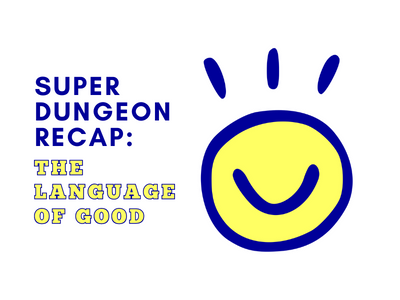Language
The Sapir-Whorf hypothesis is also known as linguistic relativity, the idea that the language we speak shapes thought. For example, while languages across the world have developed color words in the same order, indicating a universal biological constraint behind language, differences in color terms cause differences in color perception.
- The poem was inspired by TOOL’s Lateralus (song).
- The word order puzzle was based on ordinary English grammar.
- The number puzzle was based on Danish numbers combined with ternary numbers, expanded in the escape room to a balanced ternary number system. Setun is a reference to a Soviet computer design from the 1950s.
- Toki Pona is a very simple philosophical artistic constructed language designed by Sonja Lang to simplify thought and communication. It encourages mindfulness as in Zen Buddhism.
- Ithkuil, which I used for the Gate-Builders, is an incredibly complex language designed by John Quijada to express sophisticated ideas with logic, efficiency, detail, and accuracy. It is intended to enable new heights of profound thought in philosophy, art, science, and politics.
Characters
Gerald
Gerald the Shambler and the Gate-Builders as a whole are based on the Sequence from Starmoth, a similar but more terrifying ancient star-spanning empire with a habit of assimilating other civilizations via cultural manipulation. This cross-pollinated with Ella’s ideas to create the Gate-Builders featured in Super Dungeon 3. https://starmoth.space/History/xenohistory/ Gerald took further inspiration from modern AI technology and its weaknesses, such as in Winograd schema and garden path sentences. (See video by Tom Scott: https://www.youtube.com/watch?v=m3vIEKWrP9Q ) Gerald also played Sprouts, a game with deep mathematical grounding. https://en.wikipedia.org/wiki/Sprouts_(game)
Hubert and Rupert
Hubert and Rupert, who appeared in this session (but were not named), had personalities inspired by Statler and Waldorf from the muppets and names borrowed from a webcomic, Dresden Codak: https://dresdencodak.com/2005/06/22/rupert-and-hubert/
jan pona
jan pona was originally Kalisa, a sort of gay fey spirit (who instead of being very short-lived does not exist in linear time): https://starmoth.space/ShortStories/chroniclesofthedrive/ https://starmoth.space/History/xenohistory/?post_id=160&title=ladies-that-wander
radioactive pseudopenguins
The radioactive pseudopenguins are borrowed directly from Starmoth. https://old.reddit.com/r/worldbuilding/comments/sapamk/the_penguins_are_radioactive/
Week 2: Nirenberg on Nauvis
The planet of Nauvis, including the maps and enemies, is from Factorio, a factory-builder game featuring angry bug wildlife. The theme here was of biotechnological evolution, not as an observation but as an imperative. See also synthetic biology and utility fog. Nirenberg was the decipherer of the 64 genetic codons. The puzzles were based on DNA coding, starting with real DNA codons and moving on to a fictional triple-helix genetic substrate molecule. “Hello world” is a computer science tradition, while “int main” is common in C-like programming languages. https://en.wikipedia.org/wiki/C_(programming_language)
Week 3: Anansi’s Bottle
The Vlotians took inspiration from Starmoth’s Vriij. Their philosophy reflects the self-negating aspect of Buddhism. https://starmoth.space/History/xenohistory/?post_id=137&title=vriij- Candor, the Drow, mixes eastern meditative traditions into Drow dream-quests. Various tech items reference Star Trek, such as EPS conduits and Holodeck. The video game FTL: Faster Than Light contributed ship tokens and the ship interior map, while Babylon 5 gave the Gate-Builder ship image. The space combat scene and Firebase-Class battleship IPCS In Your Heart Shall Burn were adapted from Starmoth’s short story “Assault on Draugr”, though that had a happier ending. https://starmoth.space/History/humanhistory/?post_id=200&title=assault-on-draugr Certain Prophecy is a Covenant ship from Halo, while Inspiral, Coalescence, Ringdown was named for a ship from the Culture series by Iain M. Banks. The ambiguity puzzle about using each word in two different ways was flavored as a neural network training evaluation. It was borrowed from a book by Alex Bellos. https://www.theguardian.com/games/2020/oct/31/test-your-wits-with-a-book-of-ingenious-language-puzzles The puzzle about connecting cables was the three utilities problem, on a torus. Anansi’s Bottle, of course, references the tale of how Anansi spilled all the wisdom in the world. https://mythologyexplained.com/anansi-the-spider/
Week 4: Nephila
Nephila is a genus of orb-weaver spiders and a reference to Eriophora, the gate-builder asteroid-ship in the Sunflowers cycle by Peter Watts. The Island is a good introduction to the series. https://en.wikipedia.org/wiki/Nephila https://rifters.com/real/shorts/PeterWatts_TheIsland.pdf The Oberth Kuiper maneuver at the beginning of the session was a reference to an xkcd comic: https://www.explainxkcd.com/wiki/index.php/1244:_Six_Words jan pona’s sunsurfing minigame used rules borrowed from a board game, Triplanetary. http://www.sjgames.com/triplan/ The psychoanalytic dream sequence was inspired by puzzle video game Baba is You and lucid dreams. The speech and dreams of the ship itself were inspired by the hybrids from Battlestar Galactica.
Week 5: The Two Vlotias
The minigame puzzle about trying to cut off the waystation connections before the Mold reached Vlotia was the Shannon switching game. The map started out as a stargate map from Eve Online, which also provided many of my ship, planet, and background images. The story continues to borrow from the Starmoth’s Vriij. During the session I also referenced Star Trek, specifically Deep Space 9. The Gate-Builders in general mix the Federation’s culture and the Borg’s technology. Real-life biology featured this week includes manta ray intelligence, hydras’ indefinite regeneration, and octopuses dying after they’ve hatched their eggs.
Week 6: The Sporangium Eye
Monday’s session was pure toki pona, with lessons abbreviated from jan Misali’s 12 days of learning toki pona. https://www.youtube.com/playlist?list=PLjOmpMyMxd8T9lZjF36c4mn4YgwZ4ToT6 The story at the end of the tigers and the strawberries was a Zen koan. https://www.feelingoodfeelingreat.com/2014/08/07/tigers-strawberries/ https://medium.com/age-of-awareness/the-tiger-and-the-strawberry-b73de1dccf19
The farstation and its builder, the Iconoclast Seeker, was inspired by the Avid Watcher, a Sovereign from Starmoth. For images, I used XCOM’s gatekeeper. https://starmoth.space/History/xenohistory/?post_id=251&title=sequence-sovereigns
Final session puzzles:
- An adaptation of Set, the card game.
- Elder Futhark runes
- Two layers: Morse code, a Vigenere cipher.
- Rebus
- Silly phonetic misspellings, a la https://en.wikipedia.org/wiki/Ghoti. See also Mark Twain’s Plan for the Improvement of English Spelling. https://faculty.georgetown.edu/jod/texts/twain.html
- ASCII with parity for error correction and data reconstruction: https://en.wikipedia.org/wiki/Parity_bit
- Masyu https://www.puzzle-masyu.com/
Philosophy
I referenced a number of philosophies in my games. jan pona references Taoism and Zen. Where jan pona trends towards Existentialism, the black hole cult (singularity patron) seen in Aeidolon’s games trends towards Nihilism, as do the Vlotians with the negative side of Buddhism. Gerald the Shambler expresses something between Modernism and Postmodernism. Another way to see the typology of my characters is via the Vinegar tasters: On realizing existence has no inherent meaning, jan pona is at peace, Rupert and Hubert laugh (philosophical laughter: https://existentialcomics.com/comic/355), the Singularity-worshippers are in terror, and Vlotians are bitter. Gerald and the Gate-Builders meanwhile attempt to construct the purpose of life as expansionism and infinite growth. https://en.wikipedia.org/wiki/Vinegar_tasters
Music
John Quijada, creator of Ithkuil, has a prog-rock album sung entirely in the language. https://www.youtube.com/@johnquijada2756
jan Usawi is an amazing musician who sings in toki pona. Favorite tracks: “tawa lon linja”, “likujo”, “monsuta”
https://janusawi.bandcamp.com/album/lon https://janusawi.bandcamp.com/album/7-8 https://janusawi.bandcamp.com/track/monsuta
bonus vibe music:
Lorde – Te Ara Tika / The Path (track, in Māori) https://www.youtube.com/watch?v=HmTxdO4LlK4&list=PL7aRhEMqaSuT5lw0h8a4AFZf6dIlxbsg_
M83 – Oblivion (feat Susanne Sundfør) https://www.youtube.com/watch?v=UjpbQ1OWMPE
Eivør – Slør (album, in Faroese) https://www.youtube.com/watch?v=Tmu8sVs7o8Q&list=PLiN-7mukU_RHRU-6aKUFnnOUUDiZQQmNx
GUNSHIP – Dark All Day (album) https://www.youtube.com/watch?v=RHFkNuoaI3E
Boards of Canada – Trans Canada Highway (EP) https://www.youtube.com/watch?v=xrZ88ooxYf4
Redshift – Halo https://www.youtube.com/watch?v=2dE7w046lIA
God is an Astronaut – All is Violent, All is Bright https://www.youtube.com/watch?v=XUjV_zKX7xk
Explosions in the Sky – The Earth is Not a Cold Dead Place https://www.youtube.com/watch?v=veMONQwn7W8



